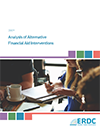This study is about student financial aid and college degree completion. It concerns a group of students who entered public postsecondary education in Washington State in the first year after their high school graduation. They all received need-based financial aid in the first year of attending college. The students were followed for six years. They differed in the amounts of financial aid they received relative to their financial need. This study is an attempt to quantify the impact on college completion that is associated with varying levels of financial aid. Study highlights include:
- Increasing student need-based financial aid is positively associated with increasing the probability of earning a college degree.
- The marginal impact of increasing a student’s financial aid seems to be greater for a student who started at a community or technical college (CTC) compared to a student who started at a 4-year institution. The increase in the probability of earning a degree associated with another $500 per year in financial aid to a CTC student is greater than a like amount provided to a 4-year student.
- Students starting at a 4-year institution are more likely to earn a degree than students beginning at a CTC.
- Students starting at a 4-year institution have more of their need met by financial aid than students starting at a CTC.
- Increasing financial aid by $500 per year has more of an impact to a CTC student than a 4-year student in regard to the amount of need being met by financial aid.
- Increasing aid is associated with increasing the probability of earning a degree; more so for a CTC student than a 4-year student.


